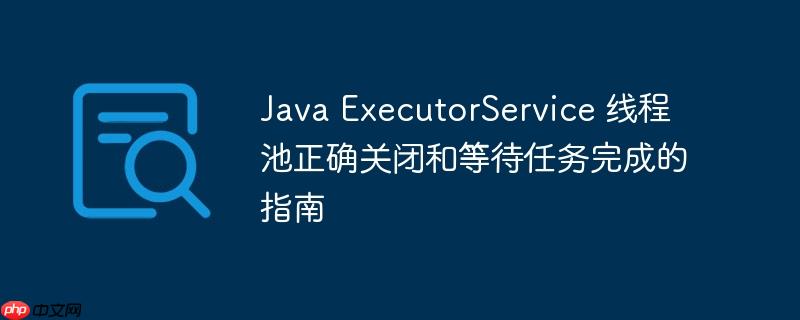
本文旨在解决 Java ExecutorService 线程池在使用 shutdown() 和 awaitTermination() 方法时,无法等待所有任务完成的问题。通过分析任务提交和线程执行的流程,本文提供了两种解决方案,确保线程池在所有任务执行完毕后才关闭,避免数据不一致等问题。
在使用 Java 的 ExecutorService 管理并发任务时,正确关闭线程池并等待所有任务完成至关重要。如果 shutdown() 方法在子任务完成前被调用,可能会导致数据丢失或不一致。本文将探讨如何确保线程池在所有任务(包括由其他任务提交的子任务)完成后才关闭。
假设我们有一个主线程,它提交了一些任务(例如 t0, t1, t2, t3)到 ExecutorService。其中,t0 又可能提交了其他的任务(例如 t4, t5)到同一个 ExecutorService。如果在 t0, t1, t2, t3 完成后立即调用 shutdown() 和 awaitTermination(),而 t4 和 t5 还在执行,那么后续的文件写入操作可能会在 t4 和 t5 完成之前执行,导致数据错误。
问题的关键在于确保在调用 shutdown() 之前,所有任务(包括子任务)都已经被提交到线程池,并且主线程知道所有任务都已经完成。以下是两种解决方案:
立即学习“Java免费学习笔记(深入)”;
如果 t0 是通过 execService.submit() 提交的任务,可以使用 Future 对象来等待 t0 完成,然后再关闭线程池。
import java.util.concurrent.ExecutorService;
import java.util.concurrent.Executors;
import java.util.concurrent.Future;
import java.util.concurrent.TimeUnit;
public class ExecutorServiceShutdownExample {
public static void main(String[] args) throws Exception {
ExecutorService execService = Executors.newFixedThreadPool(5);
// 提交 t0 任务
Future<?> t0fut = execService.submit(() -> {
System.out.println("t0 started");
// 模拟 t0 提交 t4 和 t5 任务
execService.submit(() -> System.out.println("t4 started and finished"));
execService.submit(() -> System.out.println("t5 started and finished"));
System.out.println("t0 finished");
});
// 提交其他任务 t1, t2, t3
execService.submit(() -> System.out.println("t1 started and finished"));
execService.submit(() -> System.out.println("t2 started and finished"));
execService.submit(() -> System.out.println("t3 started and finished"));
// 等待 t0 完成
t0fut.get();
// 关闭线程池
execService.shutdown();
execService.awaitTermination(60, TimeUnit.MINUTES);
System.out.println("All tasks finished, writing to file.");
}
}代码解释:
如果 t0 是一个单独的线程,而不是通过 submit() 提交的任务,可以使用 t0.join() 来等待 t0 线程结束,然后再关闭线程池。
import java.util.concurrent.ExecutorService;
import java.util.concurrent.Executors;
import java.util.concurrent.TimeUnit;
public class ExecutorServiceShutdownExample2 {
public static void main(String[] args) throws Exception {
ExecutorService execService = Executors.newFixedThreadPool(5);
// 创建 t0 线程
Thread t0 = new Thread(() -> {
System.out.println("t0 started");
// 模拟 t0 提交 t4 和 t5 任务
execService.submit(() -> System.out.println("t4 started and finished"));
execService.submit(() -> System.out.println("t5 started and finished"));
System.out.println("t0 finished");
});
// 启动 t0 线程
t0.start();
// 提交其他任务 t1, t2, t3
execService.submit(() -> System.out.println("t1 started and finished"));
execService.submit(() -> System.out.println("t2 started and finished"));
execService.submit(() -> System.out.println("t3 started and finished"));
// 等待 t0 线程结束
t0.join();
// 关闭线程池
execService.shutdown();
execService.awaitTermination(60, TimeUnit.MINUTES);
System.out.println("All tasks finished, writing to file.");
}
}代码解释:
正确关闭 ExecutorService 线程池并等待所有任务完成,是保证并发程序正确性的关键。通过等待父任务或线程完成后再调用 shutdown() 方法,可以确保所有子任务都被提交到线程池,并且在线程池关闭之前完成执行,从而避免数据丢失和不一致的问题。选择哪种方案取决于任务的提交方式,如果任务是通过 submit() 提交的,使用 Future.get() 等待;如果任务是单独的线程,使用 Thread.join() 等待。
以上就是Java ExecutorService 线程池正确关闭和等待任务完成的指南的详细内容,更多请关注php中文网其它相关文章!

每个人都需要一台速度更快、更稳定的 PC。随着时间的推移,垃圾文件、旧注册表数据和不必要的后台进程会占用资源并降低性能。幸运的是,许多工具可以让 Windows 保持平稳运行。

Copyright 2014-2025 https://www.php.cn/ All Rights Reserved | php.cn | 湘ICP备2023035733号